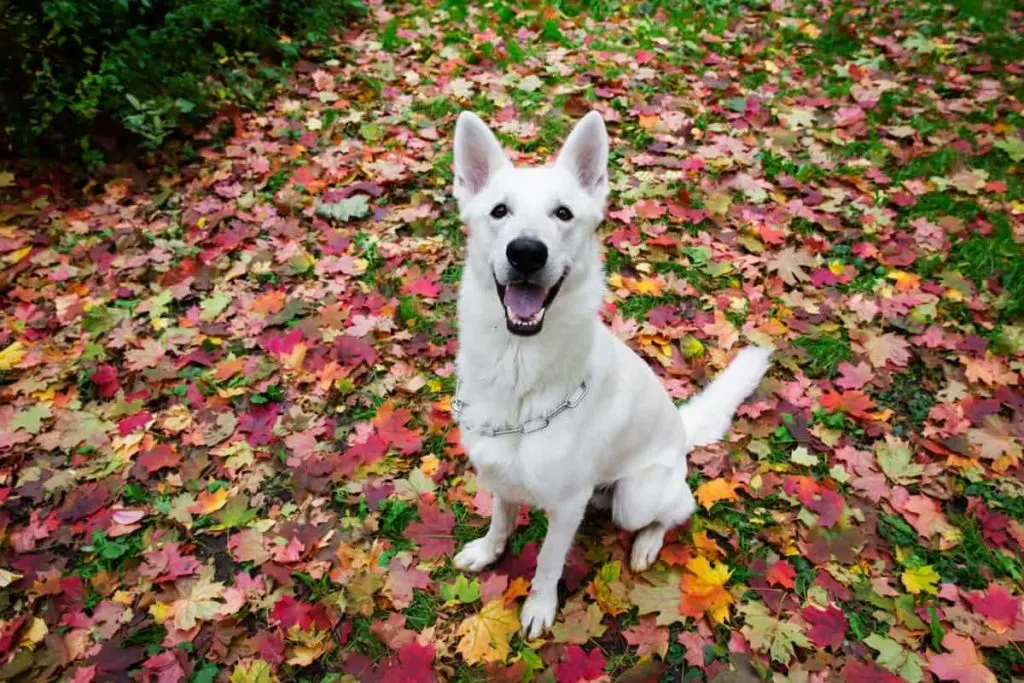
The White German Shepherd is a one of a kind pup that is sure to leave a paw print on your heart. Their striking appearance paired with their fierce loyalty makes them a treasured breed among dog lovers, and has led to their increase in popularity over the years.
In this article we offer you a complete guide on everything you need to know about the White German Shepherd, and make sure that you have the tools you need to offer them the incredible life they deserve!
Click Here to Jump to a Section
History Of The White German Shepherd
The history of the White German Shepherd is no different than other German Shepherds of any color. The White German Shepherd is a variation of the standard German Shepherd, so their story begins in Germany as well.
While attending a local dog show, Captain Max Von Stephanitz, a German dog breeder, first laid his eyes upon a striking dog named Hektor. Hektor was a striking and intelligent dog with a wolf-like appearance and a willingness to work.
Captain Max Von Stephanitz had been on a desperate hunt for the perfect working dog, and knew without a doubt that Hektor was the perfect canine to set the tone of his ideal breed.
Hektor was powerful, poised, and stood by his owner with great pride. Hektor was everything the Captain was looking for, so he immediately purchased the elegant pup. The Captain then renamed him Horand von Grafrath, who later became the first named German Shepherd.
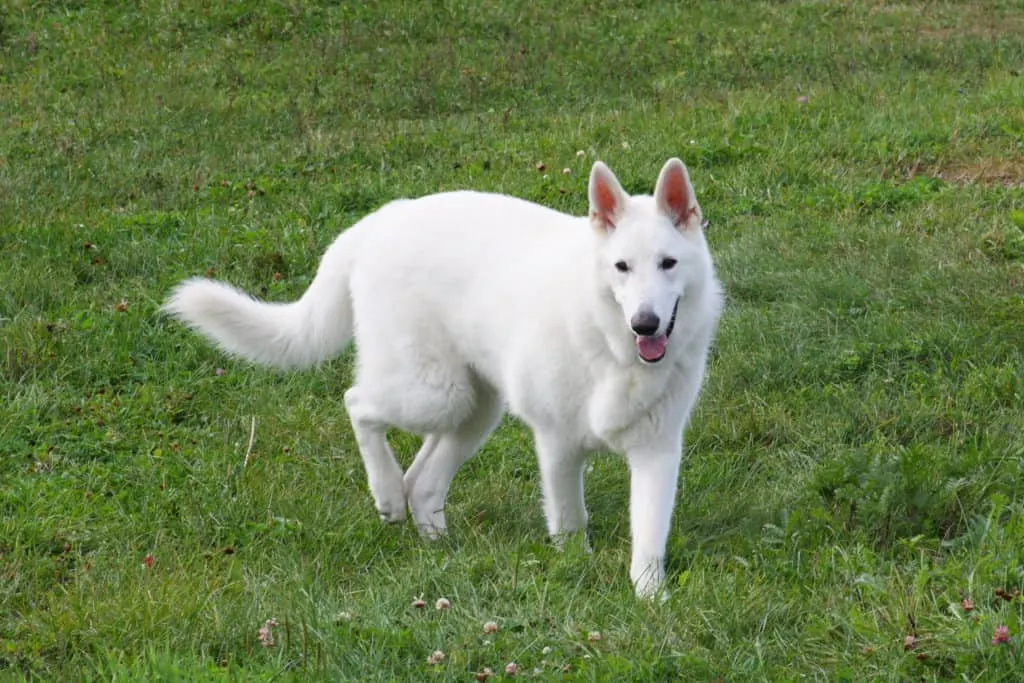
The Captain learned that Horand’s grandfather had a pure white coat that was unlike anything he had seen before. He learned that all of his German Shepherds to come would have the recessive gene that is responsible for the stunning white coat, and it wasn’t long before a line of White German Shepherds made their way around Europe.
As the breeding of the German Shepherd began to pick up, more and more people fell in love with the breed. The GSD soon made its way to the U.S. and was used in war, where their impressive working abilities stole the show.
These abilities, paired with the striking coat of the White German Shepherd, ensured that it wasn’t long before every corner of the world wanted a White German Shepherd of their own.
Appearance of the White German Shepherd
The appearance of the White German Shepherd is one of the many reasons why they are so treasured among dog lovers around the world. The White Shepherd resembles a sleek white wolf with their large frame and striking coat color, making it feel like you have a majestic wolf living with you in your home.

Their coat is either solid white or white with cream notes, and is incredibly plush with a thick undercoat. Their coat can range from short to medium with slight feathering, but is always straight and sleek.
While their coat may shine in the light, their fur is typically a bit rough to the touch. Their outer layer of fur can be coarse, but the plush undercoat tends to be a bit more soft.
The White German Shepherd has the same physical characteristics as other German Shepherds in terms of body shape and stature. They typically stand anywhere from 24 to 26 inches in height, and can weigh anywhere from 70-100 lbs depending on their bloodline.
The White German Shepherd’s build is usually muscular and slender, and they should maintain a lean appearance if they are receiving the proper diet and exercise they require. They have the standard Shepherd back slope that makes them appear as if they are standing at a slant.
Their muzzle is long and slender and their facial features appear to have sharp landmarks. Their triangular shaped ears stand upward at attention once they reach adulthood, but can remain floppy throughout their puppy life stage.
One thing is certain about the White German Shepherd’s appearance, and that’s how stunning this canine is. The White German Shepherd is sure to stop you in your tracks every time!
Personality of the White German Shepherd
White German Shepherds are known for their fierce loyalty towards those they love. The GSD is a loving companion that any family would be lucky to have, and becomes a trusting member of the pack once you welcome them into your home.
While some visitors may see your White German Shepherd as daunting due to their intense features, they are fully capable of being a lovable and welcoming friend when they are raised in an uplifting environment.
Each type of German Shepherd is known for their dignified appearance. While those who love German Shepherds know that they can be huge goofballs, you can’t deny that they take their “jobs” seriously.
Whether this is guarding their favorite humans, standing alert at your window, or providing an actual service, White German Shepherds are recognized around the world for their work ethic. They put their heart into everything they do, and make incredible companions due to this.
When they are not working or standing proudly alongside their owners, they are ready to play! The White German Shepherd loves nothing more than getting up and moving with their favorite humans, and will gladly participate in a round of fetch at any given time. No matter the activity, this goofy breed is always ready to play.
When it comes to loyalty, you can’t ask for a better companion than the White German Shepherd. The GSD chooses to form a close bond with their family, and will stand by your side through anything.
While their protective nature can make for the perfect family dog, this is a behavior that will need to be controlled in order to ensure safety within your home. To understand what this means we’ll dive into more details on their protective nature below.
White German Shepherds and Natural Protection

You will often see German Shepherds in many prestigious positions that involve protection and other serious work. This is not only due to their intelligence and work ethic, but is also due to their innate need to protect.
The first German Shepherd Dogs were bred for an array of different protection purposes, and this has remained a deep part of who they are today.
Loyalty and protection is second nature to the German Shepherd. Since the importance of protection and herding has been instilled in their DNA for so many years, your White German Shepherd is born with the need to protect their loved ones and their home.
While this urge to protect can be stronger in some dogs than others, you will likely see evidence of their past in your Shepherd’s day to day habits.
The White German Shepherd typically views their family as “their herd.” Their loyalty to their humans gives them an overwhelming urge to protect their herd, and this will often display in the actions they choose in response to certain situations.
An unsocialized White German Shepherd will often bark at people or dogs approaching you on a walk, may rush those who enter your home, or may even display aggressive tendencies in unknown situations.
While their ability to protect can be a wonderful quality, it can also be incredibly dangerous. Due to how powerful your White German Shepherd can be, you will need to understand the importance of proper socialization and training from the moment they enter your home.
Socializing and Training Your White German Shepherd
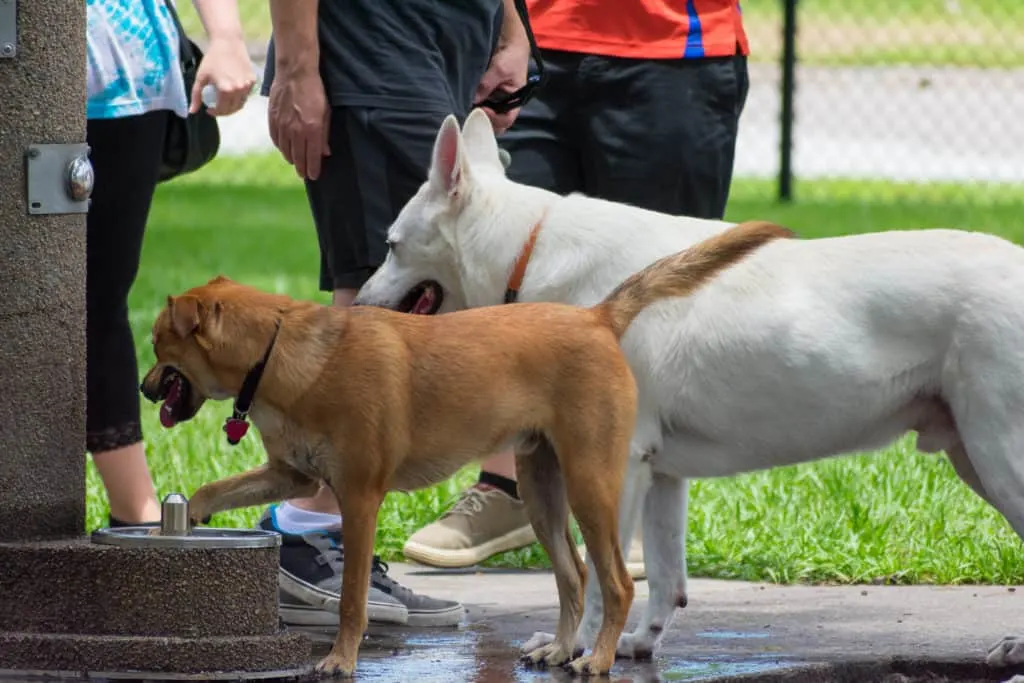
Socializing and training your White German Shepherd is possibly the most important part of owning any type of German Shepherd. As we mentioned before, the GSD’s need to protect their loved ones can be dangerous if this behavior is not fine tuned.
While it’s wonderful to have a family dog that is willing to protect their family at any moment, you cannot have a dog that is potentially dangerous to anyone that enters your home or approaches you in public. The White German Shepherd can certainly display these behaviors if they are not trained properly.
From the second you welcome your White German Shepherd into your home, you will need to begin the socialization and training process. Since this is often best achieved from the age of 8 weeks to 6 months, there’s even more of a reason to start this process early.
You want to set the tone for what’s acceptable in your home, and waiting to implement this training will only confuse your pup.
Proper socialization of your White German Shepherd includes:
- inviting other people over to your home
- introducing them to other dogs in a neutral setting
- brining other pets into your home once they are comfortable with other dogs
- taking them to public places that involve other people and animals
- taking them on walks where they are likely to see others
- introducing them to any other activity you would like them to be comfortable with
By showing your German Shepherd what a non-threatening interaction looks like, this can help them understand what it feels like to be in an opposite place such as a hostile environment.
Socialization not only makes your dog a welcomed furry member of society, but can also help them learn when it’s time to actually protect you and your home.
Obedience training is also a wonderful way to help your Shepherd gain confidence in themselves and their home. The GSD is eager to please and loves to have a job, making obedience training the perfect opportunity to do just that.
Their journey to obedience should begin from the moment they enter your home, and should be implemented each day in the form of basic manners and tricks.
White German Shepherds are an extremely intelligent breed, meaning they will catch on quickly to your training program of choice. They thrive in an environment that offers positive reinforcement style training, and truly enjoy the chance to show you how obedient they can be!
Exercise and Your White German Shepherd
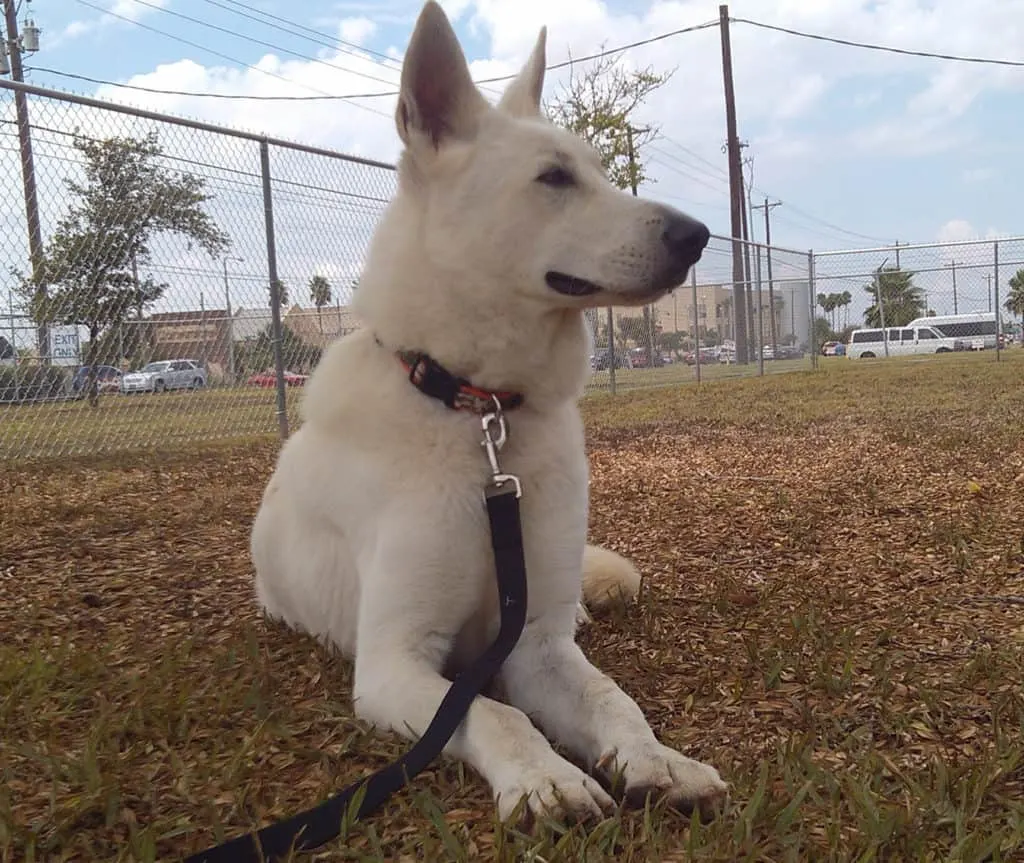
The White German Shepherd, like all other Shepherds, requires at least an hour of exercise each day. This breed is highly active and will thrive in a home that incorporates daily exercise and brisk activity.
Whether this is taking them for a long walk, playing a game of fetch, bringing them along on a hike, or any other form of physical activity, your German Shepherd will thank you!
Failing to offer the recommended amount of daily exercise can result in undesirable activity from your White German Shepherd. A cooped up German Shepherd is likely to turn destructive behavior to help them cope with their pent up energy, which is a nightmare for anyone in the home to handle.
If you want a well behaved White German Shepherd that will add joy to your life, you’ll need to be committed to helping them stay active. Daily exercise is not only best for optimum behavior, but for their overall health as well.
Feeding Your White German Shepherd
When it comes to feeding your White German Shepherd, the best option is to feed them according to weight since each German Shepherd will vary. By reviewing how many calories they need per day for their weight range, you can always be sure they are receiving the nutrients they need to thrive.
The recommended calorie intake for each weight range are as following:
| Weight in Pounds | Calories Required Each Day |
| 50 lbs | 1,000 calories each day, more if active |
| 60 lbs | 1,200 calories each day, more if active |
| 70 lbs | 1,400 calories each day, more if active |
| 80 lbs | 1,600 calories each day, more if active |
| 90 lbs | 1,800 calories each day, more if active |
| 100 lbs | 2,000 calories each day, more if active |
When welcoming a White German Shepherd into your home, experts recommend doubling the daily calorie intake per pound until they reach 1 year of age.
If they are incredibly active, you can consider doubling their intake until they reach 1.5 years of age. Puppies also require at least 3 meals a day until they reach 1 year of age since their body’s are hard at work with growth.
When feeding your German Shepherd, it’s imperative to split their total food intake into a minimum of 2 meals per day. This will help them from waiting too long in between feedings, as this can result in gastric bloat in large breed dogs.
Another way to help prevent bloat in your White Shepherd is by using a slow feeder dog bowl each time they eat. By helping them slow down and not scarf their food, you can help to prevent this serious condition.
Grooming Your White German Shepherd
If you think you want to welcome a White German Shepherd into your life, be ready to set aside some time for brushing. Since they have such a thick undercoat and coarse fur, they are known to shed quite a bit.
In order to keep your home free of excess dog fur and keep their coat looking its best, you should plan to offer a quick brush session every other day. If you are not as concerned with stray hair around your home then twice weekly brushing should be enough.
German Shepherds benefit immensely from a quality deshedding brush. Since their coat is so thick, it can be challenging for regular dog brushes to reach the under layer and strip loose fur properly.
The two deshedding tools that German Shepherd owners love are the SleekEZ Brush
and the Furminator Undercoat Shedding Tool. These brushes are one of the few options that actually get the job done!
When it comes to bathing, you should try your best to bathe your GSD no more than once a month. White German Shepherds are already more prone to skin irritation and skin allergies due to their limited skin pigment, so frequent bathing can add to their skin sensitivity.
Frequent bathing can disrupt the natural oils that are present on their skin, and most German Shepherds do not require one bath a month as it is. Most German Shepherds keep up with their grooming by implementing twice weekly brushing and baths once every 3 months, or when needed.
Average Lifespan of the White German Shepherd
On average, you can expect to have your White German Shepherd in your life for 10-12 years. While this is the standard, some German Shepherds have reached 17 years of age without any major medical concerns along the way.
Each pup will vary based on their overall health and the care they’ve received throughout their lives. No matter what, it’s important to do your very best to keep your German Shepherd healthy and happy as long as possible!
You can help to keep your White German Shepherd as healthy as possible by:
- feeding them a quality diet
- keeping up to date on their yearly vaccines and veterinary exams
- addressing any health concerns immediately as they begin
- keeping your GSD as comfortable as possible as each obstacle comes
Life Stages of the White German Shepherd
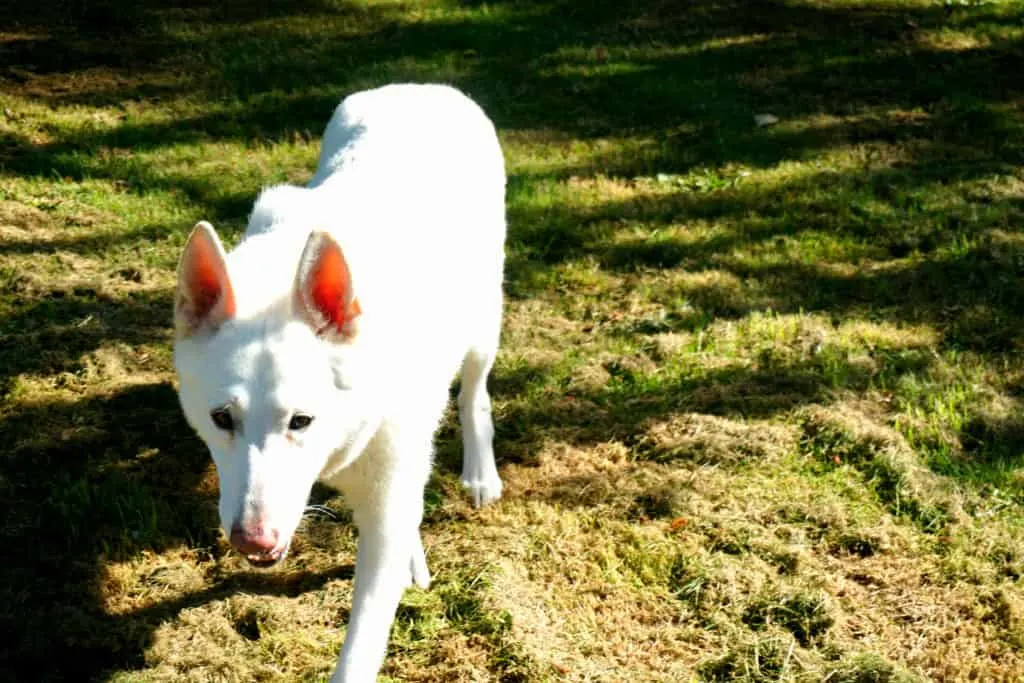
Similar to us, our German Shepherds will go through multiple life stages as they grow up alongside us in our home. Each stage will bring with it a new personality and obstacle you may have to face, so it’s best to be aware of each stage and what to expect!
- The Juvenile Stage: The juvenile stage describes the age of 3 months to 7 months in your furry friend. This is usually the time that you will be welcoming them into your home, and will quickly see how playful and curious they are about the world around them.
At this time they are most open to training, socialization, and any structure you put in place for their everyday life. By implementing your guidelines within your home at this age, it will be easiest for them to learn and carry throughout their lives.
This is also the time in their life in which they have the most energy to expel. Get ready for play time. This is also the time that you need to establish a regular veterinarian and begin their puppy vaccination.
You will also need to start monthly heartworm prevention to continue throughout their lives.
- The Adolescent Stage: The adolescent stage in a White German Shepherd refers to the age of 7 months to 3 years. Some say this is when their Shepherds were the most challenging, as they are likely to test the waters and see what they can get away with.
This is also the time where they begin to meet sexual maturity, so behavioral problems can begin if they are not properly socialized and trained. Unless you are choosing to breed your Shepherd, this is the age range in which you’ll need to talk to your vet about spaying or neutering.
You will also need to continue their yearly vaccines and monthly preventions in order to keep them as healthy as possible. German Shepherds are reaching their full size during this life stage, so be ready to have a large and in charge teenager in your home!
- The Adult GSD: Your White German Shepherd is considered an adult once they reach 3 years of age. If you followed through on your obedience training and socialization, you can finally sit back and enjoy the well behaved German Shepherd in your life.
At this point you will still need to keep up with yearly vaccines, monthly preventions, and yearly veterinary exams to make sure they are happy and healthy.
- The Senior Stage: The White German Shepherd is considered a senior pup once they reach 7 years of age. Your GSD will likely begin to slow down, enjoy their time lounging around, and may begin to experience threats to their health.
At this time it’s best to talk with your vet about starting joint supplements, beginning their senior exams, and staying on top of any medical conditions that may develop.
Health Risks of the White German Shepherd
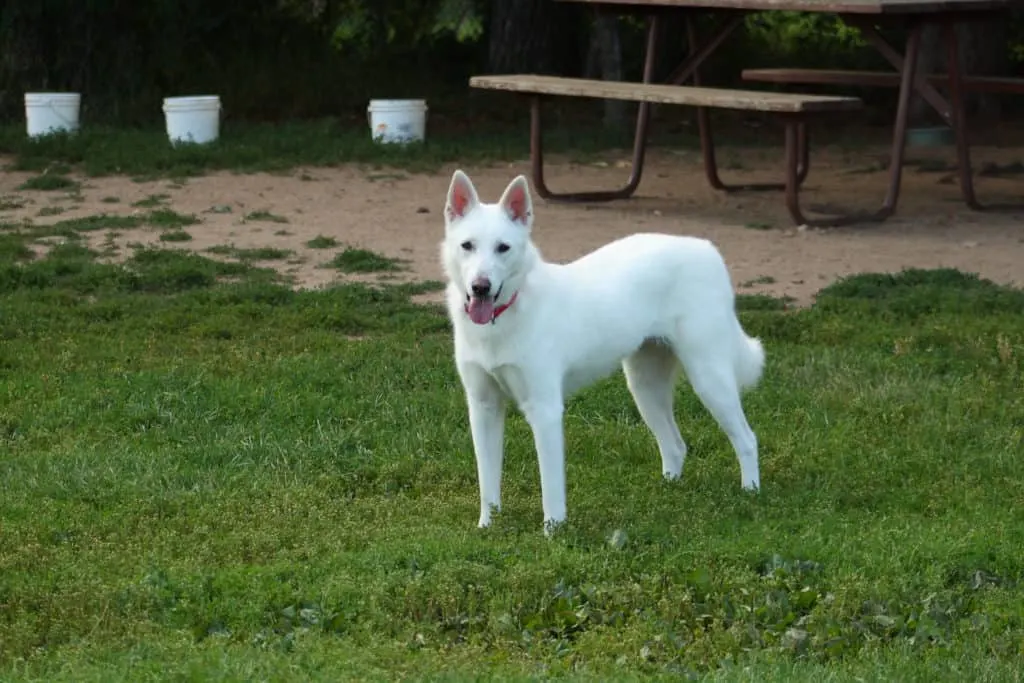
The White German Shepherd is at risk to the same medical threats as other German Shepherds. Some health conditions to be aware of when you own a GSD include:
- Hip dysplasia: Hip dysplasia refers to an abnormal formation of the hip joint that can be incredibly painful for German Shepherds. This will cause grinding of the joint, so dogs with this condition often experience pain and even lameness in serious cases.
Hip dysplasia is often an inherited condition, so it’s important to get a medical record clearing each parent of hip dysplasia when you purchase a German Shepherd puppy.
Since this condition can start at any time, you can consider starting your GSD on joint supplements once they reach 1 year of age. This can alleviate other joint conditions as well. - Arthritis: Arthritis is a common condition in German Shepherds that refers to the degenerative condition of the joints. Arthritis in dogs leads to pain, inflammation, and breakdown of the joints over time, so this condition can truly wreak havoc on your furry friend.
Since this is common in all large breeds, it’s best to speak with your vet about starting them on joint supplements once they reach 1 year of age. This can help to prevent the breakdown of joints over time. - Gastric bloat: Gastric bloat is a common and deadly condition in dogs with deep chests. During gastric bloat the stomach twists on itself, trapping the contents of the stomach and cutting off blood circulation.
Symptoms of bloat include abdominal pain, retching without any vomit production, distended abdomen, lethargy, weakness, pale gums, and collapse.
This condition is always fatal if left untreated, so it’s important to seek medical help ASAP if your dog shows any of these symptoms. - Canine degenerative myelopathy (CDM): This is a disease of the spinal cord that causes nerve cells to degenerate and stop firing, which leads to hind limb paralysis.
This is unfortunately common in German Shepherds, so it’s important to always keep a close eye on any limping or sudden change in gait.
Important Tips to Remember While Owning a White German Shepherd
Now that you’ve reviewed the entire guide to owning a White German Shepherd, you may be wondering if this is the right pup for your family. Let’s review some of the most important facts that we’ve covered to help you make the best decision possible!
Some tips to remember when owning a White German Shepherd include:
- The White German Shepherd can reach up to 26 inches in height and weigh up to 90lbs, so be prepared to have a large dog in your home.
- They are heavy shedders, but you can limit this with every other day or twice weekly brushing.
- The White German Shepherd is a loyal pup that loves to spend time with their family, so make sure you have plenty of time to offer them each day.
- The German Shepherd is born with a need to protect, so you will need to begin proper socialization and training from the moment they enter your home.
- The White German Shepherd is a goofball that loves to play, so make sure you can provide an hour of exercise each day. This will of course decrease as they approach their senior years.
- Some active German Shepherds need to consume over 2,000 calories a day, so be ready to offer plenty of quality dog food.
- Any dog that is purchased as a puppy will require their puppy vaccines, and yearly vaccines as they enter adulthood. They will also need monthly heartworm prevention.
- German Shepherds are prone to a few medical conditions, so make sure to review the list above that details these possible ailments.
If you have reviewed these tips and know you have the perfect home to offer a new furry friend, then you are ready to welcome the beautiful White German Shepherd into your family!
Final Thoughts
It’s clear that the White German Shepherd is a majestic pup that any family would be lucky to have. If you are looking to welcome a loyal, goofy, and beautiful canine friend into your life, this is the perfect dog for you.
Please, however, always remember to be a responsible dog owner. Proper socialization at an early age is key, as it will keep safe all other people and animals around your White German Shepherd, and it will also serve to make your GSD the well rounded and happy pup that it deserves to be!


